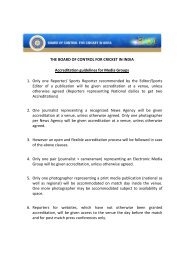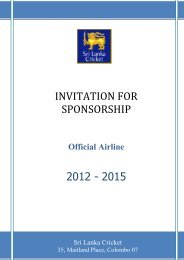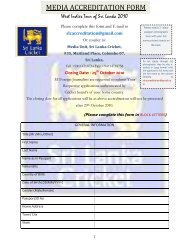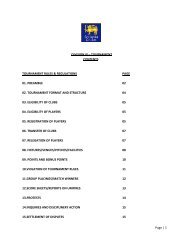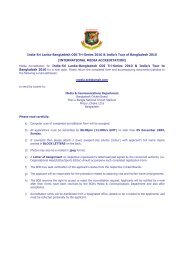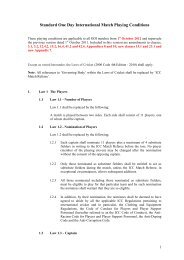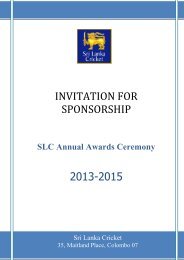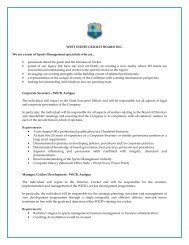Standard ODI Playing Conditions - Sri Lanka Cricket
Standard ODI Playing Conditions - Sri Lanka Cricket
Standard ODI Playing Conditions - Sri Lanka Cricket
Create successful ePaper yourself
Turn your PDF publications into a flip-book with our unique Google optimized e-Paper software.
standard ONE-day INTERNatiONAL<br />
match playing conditions 04<br />
was not a fair delivery or if it is clear to the third umpire that the<br />
batsman did not hit the ball he shall indicate that the batsman is<br />
not out and, in the case of an unfair delivery, advise the on-field<br />
umpire to signal no ball. See also paragraph 3.10 below.<br />
iv) the third umpire shall communicate his decision by the system<br />
as in paragraph 2.1 (d).<br />
v) When reviewing the TV replay(s), if the third umpire believes that<br />
the batsman may instead be out by any other mode of dismissal,<br />
beyond that initially consulted upon, he shall initiate the process<br />
described in paragraph 3.3 below as if the batsman has been<br />
given not out. This will not count as a Player Review for the<br />
purposes of paragraph 3.5.<br />
2.3 Boundary Decisions<br />
a) the on-field umpire shall be entitled to refer to the third umpire for a<br />
decision about whether the fieldsman had any part of his person in<br />
contact with the ball when he touched the boundary or when he had<br />
any part of his person grounded beyond the boundary, or whether a<br />
four or six had been scored. A decision is to be made immediately and<br />
cannot be changed thereafter.<br />
Note: If the television evidence is inconclusive as to whether or not a<br />
boundary has been scored, the status quo will remain, and it shall be<br />
treated as runs scored by the batting side.<br />
b) an on-field umpire wishing the assistance of the third umpire in this<br />
circumstance shall communicate with the third umpire by use of a<br />
two-way radio and the third umpire will convey his decision to the<br />
on-field umpire by this method.<br />
c) the third umpire may initiate contact with the on-field umpire<br />
by two-way radio if TV coverage shows a boundary line infringement<br />
or incident that appears not to have been acted upon by the<br />
on-field umpires.<br />
2.4 Obstructing the Field<br />
a) Following an appeal from the fielding side, the on-field umpire<br />
shall be entitled to consult with the third umpire if he feels that the<br />
batsman, in running between the wickets, may have significantly<br />
changed his direction (refer clause 37).<br />
b) Such consultation shall be initiated by the on-field umpire and will<br />
be done to help him decide the extent of any change in direction and<br />
whether the obstruction was wilful or not.<br />
c) Following such consultation with the third umpire, the final decision<br />
shall be indicated in the normal fashion by the relevant on-field umpire.<br />
2.5 Batsmen Running to the Same End<br />
a) in the event of both batsmen running to the same end and the<br />
umpires are uncertain over which batsmen made his ground first, the<br />
on-field umpire may consult with the third umpire.<br />
b) the procedure in paragraph 2.3 (b) shall apply.<br />
4.37



